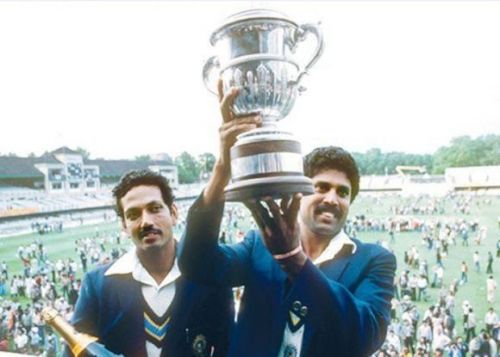Even the most ardent fans of Indian cricket would have laughed at former Australian captain Kim Hughes when he said India were ‘dark horses’ at the 1983 World Cup. But the rest as they say is history.
The International Cricket Council (ICC) took to its official Twitter handle and informed its followers of India’s feat while also sharing a picture of Kapil Dev lifting the trophy at World Cup 1983.
#OnThisDay in 1983, India won their maiden Men's @cricketworldcup title 🏆
Kapil Dev and his side stunned defending champions West Indies, beating them by 43 runs in a memorable final at Lord's 🙌 pic.twitter.com/DVchvVLH5P
— ICC (@ICC) June 25, 2020
It’s not easy to picture a team that had just played 40 ODIs before the tournament and won only one match in the previous 2 editions to lift the trophy at the Lord’s balcony. India’s tally of 40 ODIs was the 2nd least when it came to countries that had Test status at that point in time. In comparison, Australia had played 89, England 81, and West Indies 52 (of which they won 38).
‘Zero expectations’ worked
The odds were stacked against Kapil Dev’s men — 66:1. Ayaz Memon, who was one of the few journalists from the country to cover the 3rd edition of the 50-over World Cup from England had said in an interview to AFP that there was ‘zero expectations’ and that he did not even watch India’s opener against West Indies thinking ‘they would lose easily’.
Not until 1980 when India toured Australia for a tri-nation series in 1980 did India take the ODDI format seriously, Sunil Gavaskar had told India Today at Salaam Cricket 2019. India played as many as 6 ODIs in a span of fewer than 3 months Down Under and managed to win 3 matches, including one against Australia.
“Our turnaround in the whole format started when we went to Australia in 1980 where we played 10 one-day games. That’s the first time we started to take ODI cricket seriously.
“Earlier on, we just went in like a Sunday game. This time there were prizes at the end. There was a trophy to be won as well. Earlier on, there was nothing to be won. Then we came to the West Indies in 1983 and we beat them in a match in Guyana,” Gavaskar had said.
India were still the rank outsiders at the 1983 World Cup. They had beaten West Indies once in March in the World Cup year in Guayana after posting 282 with Gavaskar scoring 90 from 117 balls but it would have been perceived as a bad day in the office for the mighty West Indies.
Guyana win was not a fluke
India’s opening match was against Clive Lloyd’s West Indies at Manchester. Kapil’s men proved the win in Guyana a couple of months ago wasn’t just a fluke.
Led by Yashpal Sharma’s 120-ball 89 and Sandeep Patil’s steady helping hand followed by handy contributions in the lower-order from Madan Lal and Roger Binny, India posted 262. West Indies were bundled out for 228 after Binny jolted the mighty West Indies top order.
In the 2nd match against Zimbabwe, Lal and Binny were at it again as they helped India restrict the opposition to 155. Mohinder Amarnath and Patil led the show with the bat as India won without dropping a sweat.
2 wins in as many matches would have felt great for the underdogs. However, things changed quickly.
The trough after the opening crest
In their next match against Australia in Nottingham, Trevor Chappel’s hundred and Ken MacLeay’s 6-wicket haul brought the high-flying Indian team down to earth. Australia posted 320 in 50 overs, bowled India out for 158.
India met West Indies in their next outing. This time, a Viv Richards’ hundred helped West Indies avenge their defeat in the opener.
India were staring at an early exit. They faced must-win situations in their next 2 matches.
The iconic 138 ball 175
Then came the iconic clash against Zimbabwe at Tunbridge Wells. India, in a do-or-die situation, were starting at death, reeling at 17 for 5 after opting to bat.
Then came the Kapil Dev innings that has an important place in the history of Indian cricket. Kapil scored 175 in 138 balls, hitting 16 sixes and 6 boundaries and single-handedly helped India clinch a 31-run win and an opportunity to live to fight another day in the Old Blighty. It’s a shame that the knock wasn’t captured as it was not televised during the World Cup.
No stopping India after Kapil’s magic
Kapil’s 175 did the magic for Team India. In the final group-stage match, India walloped Australia by 118 runs after posting 240. Yashpal top-scored with 40 but 9 of the 11 batsmen scored in double-digits. Lal and Binny blew the Australian batting line-up away.
In the semi-final, India outclassed hosts England with an all-round effort.
The final showdown: The LORD’s final
By the time India reached the final, they were no more rank outsiders. Millions were glued to their TV sets to watch what Kapil’s men would do in the final.
It was their third meeting with the West Indies in the World Cup. This time, it was the most important of it all — the final at the Lord’s.
India were sent in to bat by Clive Lloyd. They managed just 183 after Srikkanth top-scored with 38 in an otherwise unimpressive batting display.
India did not have the runs on the board. What they had was a ‘nothing-to-lose’ attitude and belief that they carried after a spirited campaign.
All that West Indies could manage with the bat was 140 with 7 single-digit scores.
Kapil’s Devils did the unthinkable. The inspiring skipper lifted the World Cup at the Lord’s balcony.
As Srikkanth recently said, the 1983 World Cup was a ‘turning point not just for Indian cricket but for Indians in general’.
Among the ones who watched India’s win and ‘celebrated till late in the night’ were Sachin Tendulkar and Rahul Dravid.
PNN







































